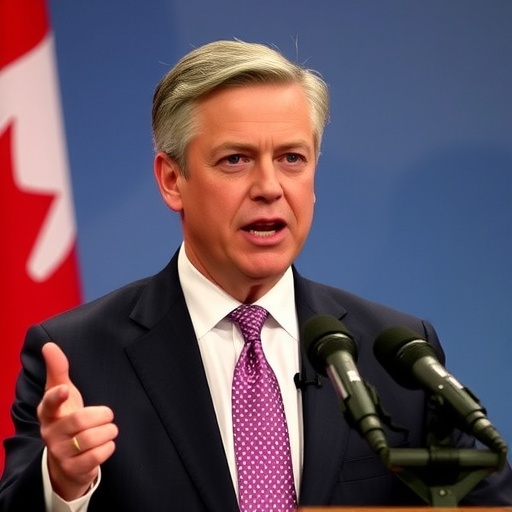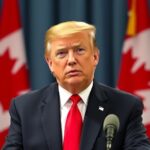Canada’s PM Carney Defends Free Trade Amid Trump’s Escalating Tariff Threats on Allies
In a bold address to the nation, Canadian Prime Minister Mark Carney has reaffirmed Canada’s unwavering commitment to international trade rules, delivering what many interpret as a direct challenge to U.S. President Donald Trump’s aggressive protectionist agenda. As Trump ramps up threats of new tariffs against close trading partners like Canada, the rhetoric from Ottawa signals a deepening rift in North American economic relations, with potential ripple effects across global markets.
Carney‘s remarks, delivered during a high-stakes economic forum in Toronto on Wednesday, come at a critical juncture. With the U.S. economy showing signs of slowdown and inflation pressures mounting, Trump’s administration has signaled intentions to impose tariffs on imports from Canada, citing national security and unfair trade practices. This escalation could disrupt billions in bilateral trade, straining the longstanding partnership under the USMCA agreement.
Carney’s Fiery Defense of Multilateral Trade Principles
Prime Minister Carney wasted no time in laying out his vision for Canada’s role in the global economy. ‘Canada will not retreat from the principles that have built our prosperity,’ Carney declared, his voice steady amid applause from business leaders and policymakers. He emphasized the importance of adhering to World Trade Organization (WTO) guidelines, subtly contrasting this with what he called ‘unilateral actions that undermine collective progress.’
This veiled critique of Trump was not lost on observers. Carney, a former Bank of England governor with deep roots in international finance, drew on his expertise to highlight the dangers of protectionism. ‘Trade is the lifeblood of our economy,’ he said, pointing to Canada’s export-driven growth, which accounts for nearly 30% of its GDP. In 2023 alone, trade between Canada and the U.S. reached $1.2 trillion, with key sectors like automotive, energy, and agriculture heavily intertwined.
Carney’s speech also touched on recent data from Statistics Canada, which reported a 2.5% dip in manufacturing exports to the U.S. in the first quarter of this year, partly attributed to lingering uncertainties from previous tariff skirmishes during Trump’s first term. ‘We must protect the rules-based order that has prevented trade wars from spiraling out of control,’ Carney urged, invoking memories of the 2018 steel and aluminum tariffs that cost Canadian jobs and billions in revenue.
Analysts note that Carney’s approach is strategic. By framing the issue around shared values rather than confrontation, he aims to rally domestic support while appealing to moderate voices in Washington. ‘This is Carney at his best—calm, authoritative, and forward-thinking,’ said Dr. Elena Vasquez, a trade economist at the University of Ottawa. Her comments underscore how Carney’s background in global banking positions him uniquely to navigate these tensions.
Trump’s Tariff Blitz Targets Canada and Beyond
Across the border, President Trump has doubled down on his ‘America First’ doctrine, announcing on Tuesday via social media that new tariffs could hit Canadian goods as early as next month. ‘Canada has been taking advantage of us for too long—time to level the playing field,’ Trump posted, echoing sentiments from his campaign trail. The proposed 25% tariffs would primarily affect lumber, dairy, and auto parts, sectors where Canada holds a competitive edge.
This isn’t the first time Trump has wielded tariffs as a negotiating tool. During his presidency, similar measures led to retaliatory actions from Canada, including $12.6 billion in countermeasures on U.S. products like whiskey and steel. Now, with midterm elections looming in the U.S., Trump’s team sees tariffs as a way to appease manufacturing states in the Rust Belt. White House economic advisor Peter Navarro defended the move in a Fox News interview, stating, ‘These tariffs will bring jobs back home and protect American workers from unfair competition.’
However, the threats extend beyond Canada. Trump has also warned Mexico and the European Union of impending duties, creating a web of uncertainty. According to a recent report from the Peterson Institute for International Economics, such broad tariffs could shave 0.5% off global GDP growth in 2025. For Canada, the stakes are personal: over 75% of its exports go to the U.S., making it the most vulnerable among allies.
Canadian officials, including Foreign Affairs Minister Mélanie Joly, have responded with measured outrage. ‘We value our partnership with the United States, but we will not stand idly by as our economy is threatened,’ Joly said in a press briefing. This coordinated messaging from Carney’s government highlights a unified front, blending diplomacy with firmness.
Economic Ripples: How Tariffs Could Cripple Canadian Industries
The potential impact on Canada’s economy is staggering. A full-scale tariff war could cost the country up to 200,000 jobs, according to projections from the Canadian Chamber of Commerce. In the automotive sector alone, which employs over 500,000 Canadians, integrated supply chains mean that a tariff on U.S.-bound vehicles could halt production lines overnight. Ford and General Motors plants in Ontario, for instance, rely on seamless cross-border flows of parts valued at $100 billion annually.
Agriculture faces similar perils. Canadian dairy farmers, already navigating U.S. complaints over supply management, could see exports of cheese and milk products plummet by 40%, per industry estimates. ‘We’re not just talking numbers; these are family farms and livelihoods at risk,’ warned Sarah Thompson, president of the Dairy Farmers of Canada, in an exclusive interview. She recounted how previous tariffs forced some operations to downsize, with one Quebec cooperative losing 15% of its workforce in 2019.
Energy trade, a cornerstone of the relationship, is also in the crosshairs. Canada supplies 60% of U.S. crude oil imports, primarily from Alberta’s oil sands. New tariffs could drive up gasoline prices on both sides of the border, exacerbating inflation. The Bank of Canada has already revised its growth forecast downward to 1.8% for 2024, citing trade uncertainties as a key factor.
Small businesses, often the backbone of Canada’s economy, are bracing for the worst. A survey by the Federation of Independent Business revealed that 62% of small exporters fear tariffs will increase costs by at least 20%. ‘We’ve barely recovered from COVID; this could be devastating,’ said one Toronto-based exporter of machinery parts, who requested anonymity due to ongoing U.S. contracts.
Yet, amid the gloom, some sectors see opportunity. Renewable energy firms in British Columbia are lobbying for exemptions, arguing that green tech collaboration could align with Biden-era policies—though Trump’s return complicates that narrative.
Industry Leaders and Experts Sound the Alarm on Trade Fallout
The business community is mobilizing. At the Toronto forum where Carney spoke, executives from major firms like Bombardier and Suncor voiced support for a robust Canadian response. ‘Tariffs don’t just hurt Canada—they weaken the entire North American competitive edge against China,’ asserted David Johnston, CEO of the Canadian Manufacturers & Exporters association. He cited data showing that U.S.-China trade diversion has already boosted Canadian shipments by 15% in electronics, but new U.S. barriers could reverse those gains.
International experts are weighing in too. WTO Director-General Ngozi Okonjo-Iweala praised Carney’s stance in a statement, noting, ‘Adherence to multilateral rules is essential for sustainable growth.’ Meanwhile, U.S. Chamber of Commerce President Suzanne Clark warned of mutual destruction: ‘Tariffs on allies like Canada will raise prices for American consumers and businesses alike.’
In academic circles, debates rage over long-term strategies. Professor Michael Hart from Carleton University argued in a recent op-ed that Canada should diversify trade partners, pointing to the Comprehensive Economic and Trade Agreement (CETA) with Europe, which has increased EU exports by 20% since 2017. ‘Relying too heavily on the U.S. is a vulnerability we must address,’ Hart said.
Polls reflect public anxiety: A Leger survey found 68% of Canadians view Trump’s tariffs as a threat to national security, up from 55% last year. This sentiment bolsters Carney’s position, giving his government leverage in upcoming negotiations.
Navigating the Path Forward: Diplomacy, Diversification, and Deadlines
As tensions mount, both sides face pressing deadlines. The USMCA’s review clause activates in 2026, providing a window for renegotiation, but interim talks could begin sooner. Carney has instructed his trade team to prepare contingency plans, including WTO complaints and targeted retaliations if tariffs materialize.
Optimists point to past resolutions, like the 2019 lifting of steel tariffs after intense diplomacy. U.S. Ambassador to Canada David Cohen hinted at flexibility in a closed-door meeting, suggesting that ‘quiet conversations’ could avert crisis. For Canada, bolstering ties with Asia-Pacific nations via the CPTPP agreement offers a hedge, with exports to those markets up 25% in the last two years.
Looking ahead, the implications are profound. A prolonged trade spat could accelerate supply chain reshoring, benefiting neither economy fully. Economists forecast that de-escalation might stabilize currency fluctuations—the Canadian dollar has already dipped 2% against the U.S. dollar this week. Carney’s closing words at the forum encapsulated the hope: ‘Together, we can choose cooperation over conflict, ensuring prosperity for generations.’
Stakeholders on both sides of the border are watching closely. With global events like the G7 summit on the horizon, the Carney-Trump dynamic will test the resilience of alliances forged in the post-WWII era. For now, Canada’s firm stance serves as a beacon, reminding the world that trade wars are rarely won unilaterally.









